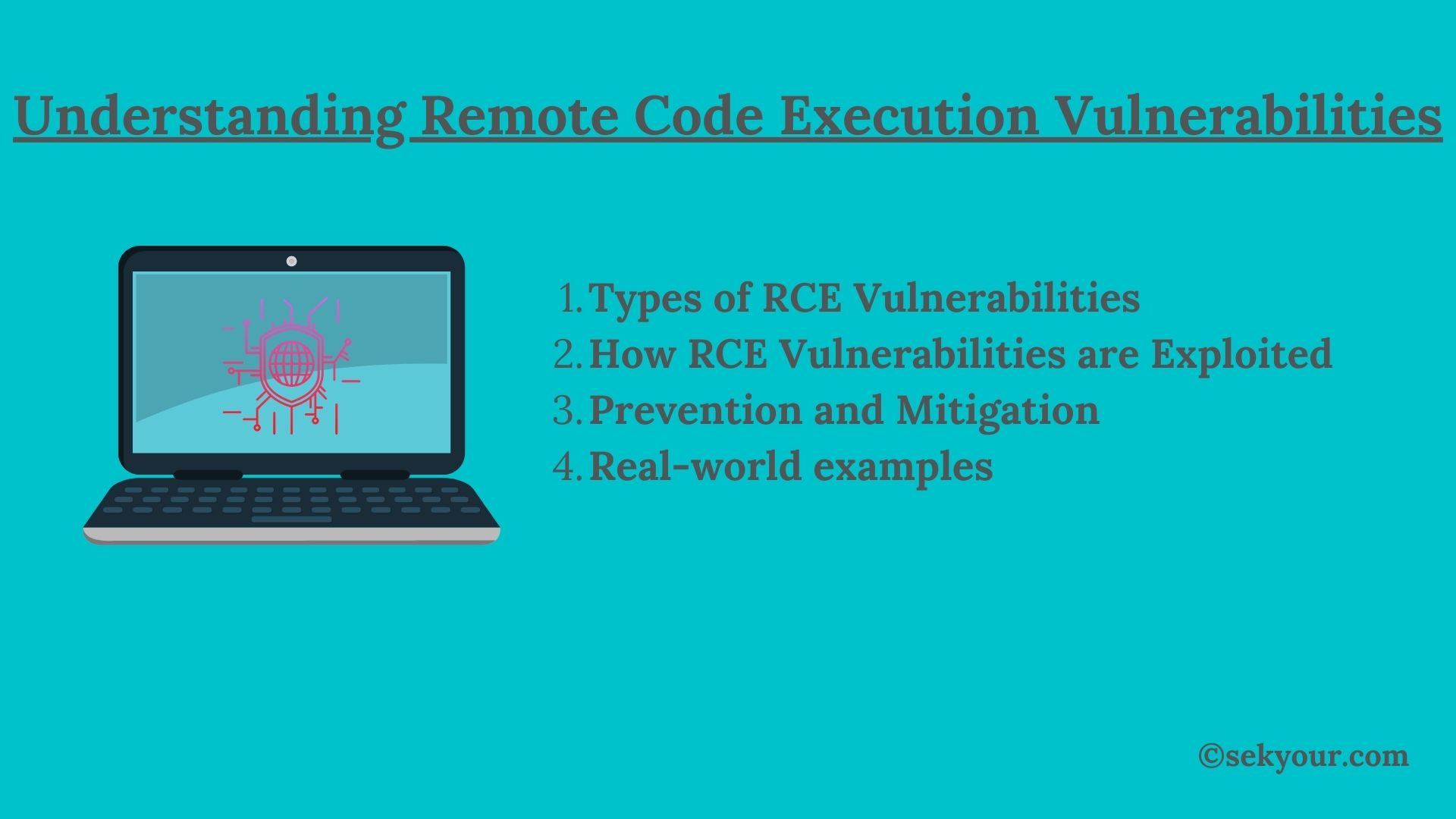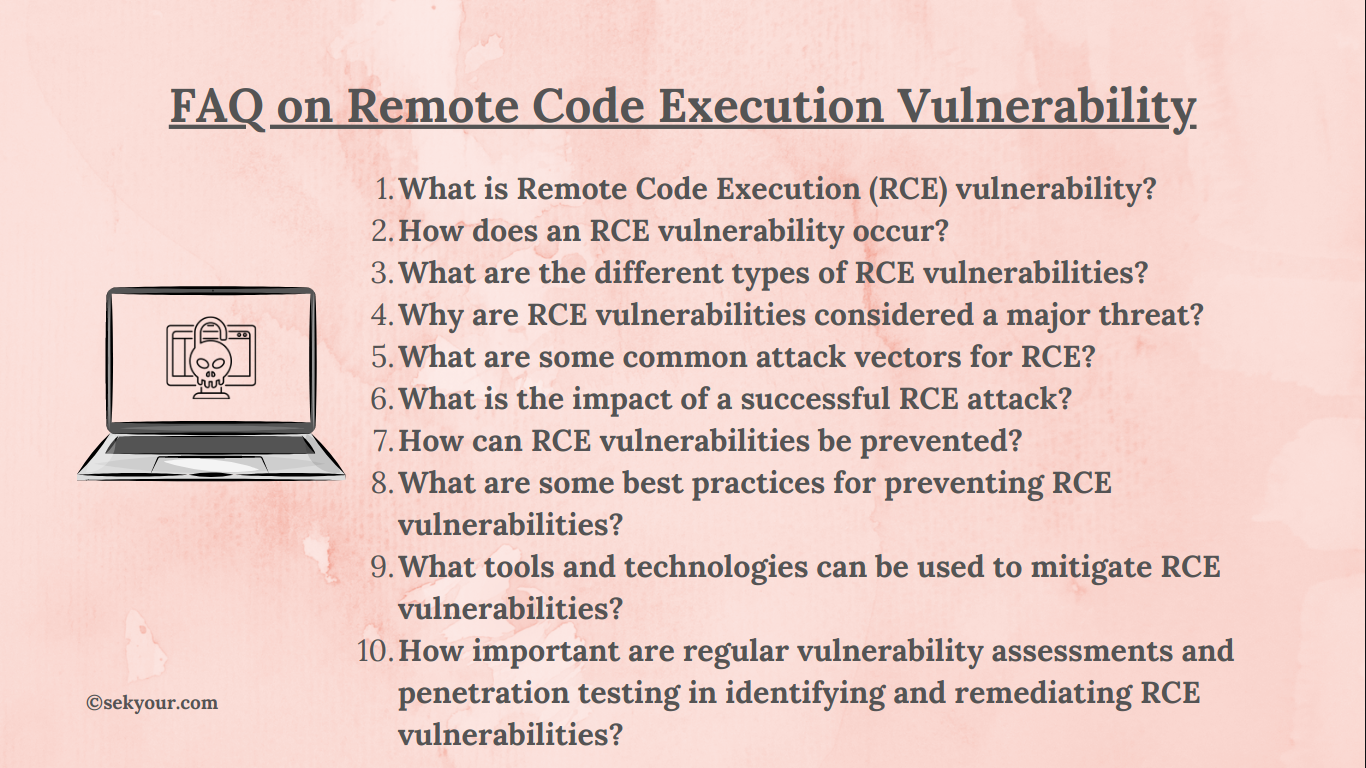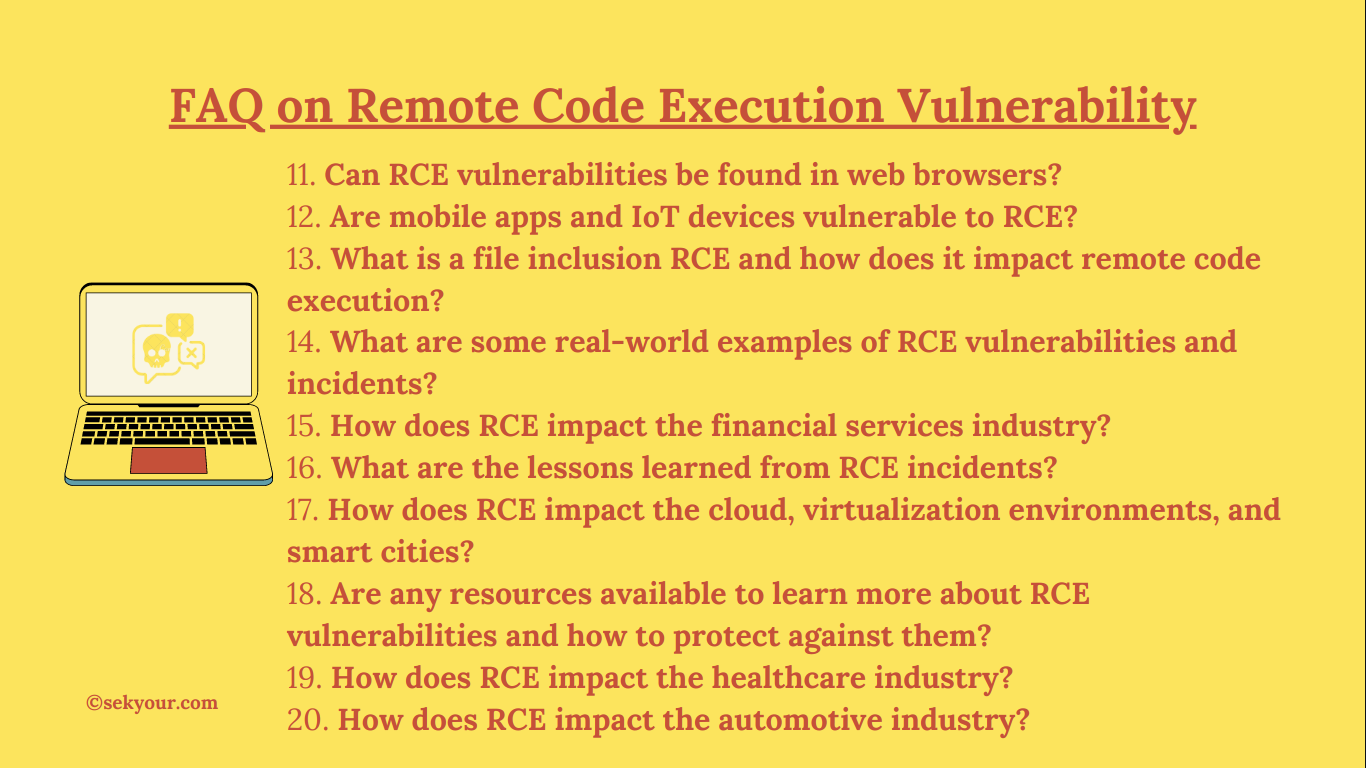1. Introduction
Remote Code Execution (RCE) is a type of security vulnerability that allows an attacker to execute arbitrary code on a target system. This can occur when an application or system does not properly validate user input, allowing an attacker to inject malicious code into the system. RCE vulnerabilities are considered a major threat because they can give an attacker complete control of a system, allowing them to steal sensitive information, install malware, or disrupt operations.
This article will discuss the dangers of RCE vulnerabilities and why it is important for organizations and individuals to understand them. We will examine real-world examples of RCE attacks and their impact on businesses and individuals. We will also discuss best practices for preventing RCE vulnerabilities and mitigating the risk of an attack. Understanding the risks associated with RCE vulnerabilities is crucial for protecting your systems and data from cyber threats.

2. Types of RCE Vulnerabilities
Remote Code Execution (RCE) vulnerabilities can be broadly classified into server-side and client-side.
Server-side RCE occurs when an attacker can execute arbitrary code on the server side of a web application, allowing them to access sensitive information and disrupt operations. These vulnerabilities often occur due to poor input validation or insecure coding practices.
Client-side RCE occurs when an attacker can execute arbitrary code on the client side, such as in a web browser. This vulnerability can allow an attacker to steal sensitive information or perform malicious actions on the client’s system. Insecure coding practices or vulnerable third-party libraries typically cause these vulnerabilities.
File inclusion RCE is a specific type of RCE vulnerability that occurs when a web application is vulnerable to arbitrary file inclusion. This vulnerability can allow an attacker to include remote files on the server, potentially allowing them to execute arbitrary code on the system. This vulnerability significantly impacts remote code execution, as an attacker can gain access to sensitive information and disrupt operations.
3. How RCE Vulnerabilities are Exploited
Attackers exploit RCE vulnerabilities to gain unauthorized access to a system and execute arbitrary code. Several techniques are used to discover RCE vulnerabilities, such as vulnerability assessment and penetration testing. Vulnerability assessment is identifying, classifying, and prioritizing vulnerabilities in a system, whereas penetration testing simulates an attack on a system to assess its security.
Common attack vectors for RCE include web applications, mobile apps, and IoT devices. Web applications are a popular target for RCE attacks due to the vast number of vulnerabilities that can be found in these systems. Mobile apps and IoT devices are also vulnerable to RCE attacks due to their increasing popularity and the lack of security measures.
The impact of successful RCE attacks can be severe, including data breaches, unauthorized access, and system shutdowns. Data breaches can lead to the theft of sensitive information, unauthorized access can allow an attacker to take control of a system, and system shutdowns can disrupt operations and cause financial losses. RCE vulnerabilities can also be used to install malware and perform other malicious actions on a system.
4. Prevention and Mitigation
Preventing RCE vulnerabilities is crucial for protecting systems and data from cyber threats. Some best practices for preventing RCE include secure coding practices and input validation. Secure coding practices involve following industry standards and guidelines for writing secure code, such as OWASP Top 10, to minimize the risk of vulnerabilities. Input validation ensures that user input is properly sanitized and validated before an application processes it.
To mitigate RCE vulnerabilities, commonly used tools and technologies include intrusion detection and prevention systems (IDPS). IDPS are designed to detect and prevent unauthorized access to a system by monitoring network traffic and identifying suspicious activity. Firewalls, antivirus software and web application firewall (WAF) can also prevent RCE vulnerabilities.
Regular vulnerability assessments and penetration testing are essential for identifying and remediating RCE vulnerabilities. Vulnerability assessments involve identifying, classifying, and prioritizing vulnerabilities in a system, whereas penetration testing simulates an attack on a system to assess its security. These assessments and testing can help organizations identify vulnerabilities and take the necessary steps to remediate them, thus mitigating the risk of a successful RCE attack.
5. Real-world examples
There have been several high-profile RCE vulnerabilities and incidents in recent history. For example, in 2020, a critical RCE vulnerability was discovered in the Chrome browser that could allow an attacker to execute arbitrary code on a user’s system. Another example is the Mirai malware, which exploited RCE vulnerabilities in IoT devices to launch a massive DDoS attack in 2016. In the financial services industry, there have been incidents where RCE vulnerabilities have been used to steal sensitive information and disrupt operations.
These incidents highlight the importance of securing against client-side RCE and preventing file inclusion attacks. For example, the Chrome browser vulnerability shows the importance of keeping software updated and patching vulnerabilities as soon as possible. The Mirai malware incident highlights the importance of securing IoT devices and ensuring they are correctly configured and secured.
The impact of these incidents can be severe, including data breaches, unauthorized access, and system shutdowns. Organizations and individuals must understand the risks associated with RCE vulnerabilities and take steps to prevent and mitigate them. This includes implementing secure coding practices, input validation, and regular vulnerability assessments and penetration testing. It is also important to keep software up to date, have intrusion detection and prevention systems in place, and use firewalls, antivirus software, and web application firewall (WAF) to prevent RCE vulnerabilities.
6. Conclusion
In conclusion, the article has discussed the dangers of Remote Code Execution (RCE) vulnerabilities and why it is important for organizations and individuals to understand them. It explained that RCE vulnerabilities can occur when an application or system does not properly validate user input, allowing an attacker to inject malicious code into the system. It also covered the two types of RCE vulnerabilities, how they are exploited, the impact of successful RCE attacks, and the prevention and mitigation strategies.
It is important to note that RCE vulnerabilities remain a major threat, particularly in the cloud, virtualization environments, and smart cities. These environments have their unique security challenges and organizations need to remain vigilant in protecting against RCE vulnerabilities.
Several resources are available for readers who want to learn more about RCE vulnerabilities and how to protect against them. For example, the healthcare and automotive industry have their specific security challenges, and organizations in these industries need to understand the risks associated with RCE vulnerabilities and take steps to prevent and mitigate them. Additionally, industry-specific organizations such as the OWASP, SANS and NIST provide information and best practices for protecting against RCE vulnerabilities.
7. FAQ on Remote Code Execution Vulnerability

1. What is Remote Code Execution (RCE) vulnerability?
Remote Code Execution (RCE) is a type of security vulnerability that allows an attacker to execute arbitrary code on a target system. This can occur when an application or system does not properly validate user input, allowing an attacker to inject malicious code into the system.
2. How does an RCE vulnerability occur?
RCE vulnerabilities occur when an application or system does not properly validate user input, allowing attackers to inject malicious code into the system. This can happen due to poor input validation, insecure coding practices, or using vulnerable third-party libraries.
3. What are the different types of RCE vulnerabilities?
There are two main types of RCE vulnerabilities: server-side and client-side. Server-side RCE occurs when an attacker can execute arbitrary code on the server side of a web application. Client-side RCE occurs when an attacker can execute arbitrary code on the client-side, such as in a web browser.
4. Why are RCE vulnerabilities considered a major threat?
RCE vulnerabilities are considered a major threat because they can give an attacker complete control of a system, allowing them to steal sensitive information, install malware, or disrupt operations. These vulnerabilities can also allow attackers to gain access to sensitive information and disrupt operations, making them a major risk for organizations and individuals.
5. What are some common attack vectors for RCE?
Common attack vectors for RCE include web applications, mobile apps, and IoT devices. Web applications are a popular target for RCE attacks due to the vast number of vulnerabilities that can be found in these systems. Mobile apps and IoT devices are also vulnerable to RCE attacks due to their increasing popularity and the lack of security measures.
6. What is the impact of a successful RCE attack?
The impact of a successful RCE attack can be severe, including data breaches, unauthorized access, and system shutdowns. Data breaches can lead to the theft of sensitive information, unauthorized access can allow an attacker to take control of a system, and system shutdowns can disrupt operations and cause financial losses. RCE vulnerabilities can also be used to install malware and perform other malicious actions on a system.
7. How can RCE vulnerabilities be prevented?
RCE vulnerabilities can be prevented by implementing secure coding practices, input validation, and regular vulnerability assessments and penetration testing. Organizations can also use intrusion detection and prevention systems (IDPS), firewalls, antivirus software, and web application firewall (WAF) to prevent RCE vulnerabilities.
8. What are some best practices for preventing RCE vulnerabilities?
Best practices for preventing RCE vulnerabilities include secure coding, input validation, and regular vulnerability assessments and penetration testing. Organizations can also use intrusion detection and prevention systems (IDPS), firewalls, antivirus software, and web application firewall (WAF) to prevent RCE vulnerabilities.
9. What tools and technologies can be used to mitigate RCE vulnerabilities?
Common tools and technologies for mitigating RCE include intrusion detection and prevention systems (IDPS), firewalls, antivirus software, and web application firewall (WAF). These tools and technologies can help detect and prevent unauthorized access to a system by monitoring network traffic and identifying suspicious activity.
10. How important are regular vulnerability assessments and penetration testing in identifying and remediating RCE vulnerabilities?
Regular vulnerability assessments and penetration testing are important for identifying and remediating RCE vulnerabilities. Vulnerability assessments involve identifying, classifying, and prioritizing vulnerabilities in a system, whereas penetration testing simulates an attack on a system to assess its security. These assessments and testing can help organizations identify vulnerabilities and take the necessary steps to remediate them, thus mitigating the risk of a successful RCE attack.

11. Can RCE vulnerabilities be found in web browsers?
Yes, RCE vulnerabilities can be found in web browsers. For example, a critical RCE vulnerability was discovered in the Chrome browser in 2020 that could allow an attacker to execute arbitrary code on a user’s system.
12. Are mobile apps and IoT devices vulnerable to RCE?
Yes, mobile apps and IoT devices are vulnerable to RCE attacks due to their increasing popularity and the lack of security measures. These devices often have vulnerabilities that attackers can exploit to gain unauthorized access and execute arbitrary code.
13. What is a file inclusion RCE and how does it impact remote code execution?
File inclusion RCE is a specific type of RCE vulnerability that occurs when a web application is vulnerable to arbitrary file inclusion. This vulnerability can allow an attacker to include remote files on the server, potentially allowing them to execute arbitrary code on the system. This vulnerability significantly impacts remote code execution as an attacker can gain access to sensitive information and disrupt operations.
14. What are some real-world examples of RCE vulnerabilities and incidents?
There have been several high-profile RCE vulnerabilities and incidents in recent history, including in web browsers, smart home devices, and the financial services industry. One example is the Mirai malware, which exploited RCE vulnerabilities in IoT devices to launch a massive DDoS attack in 2016.
15. How does RCE impact the financial services industry?
RCE vulnerabilities can have a significant impact on the financial services industry. There have been incidents where RCE vulnerabilities have been used to steal sensitive information and disrupt operations. Financial services organizations must be particularly vigilant in protecting against RCE vulnerabilities to protect sensitive information and maintain business operations.
16. What are the lessons learned from RCE incidents?
The lessons learned from RCE incidents include keeping software up to date and patching vulnerabilities as soon as possible, securing IoT devices and ensuring that they are properly configured and secured, and securing against client-side RCE and preventing file inclusion attacks.
17. How does RCE impact the cloud, virtualization environments, and smart cities?
RCE vulnerabilities remain a significant threat in the cloud, virtualization environments, and smart cities. These environments have their unique security challenges, and organizations need to remain vigilant in protecting against RCE vulnerabilities.
18. Are any resources available to learn more about RCE vulnerabilities and how to protect against them?
Several resources are available for learning more about RCE vulnerabilities and how to protect against them. Industry-specific organizations such as OWASP, SANS, and NIST provide information and best practices for protecting against RCE vulnerabilities.
19. How does RCE impact the healthcare industry?
RCE vulnerabilities can significantly impact the healthcare industry, leading to data breaches and unauthorized access to sensitive patient information. Healthcare organizations need to understand the risks associated with RCE vulnerabilities and take steps to prevent and mitigate them.
20. How does RCE impact the automotive industry?
RCE vulnerabilities can have a significant impact on the automotive industry as it can lead to unauthorized access to car systems and the potential for physical harm. It is important for automotive organizations to understand the risks associated with RCE vulnerabilities and take steps to prevent and mitigate them.